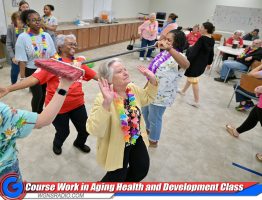 Have you ever sat around for a long time, and needed to get up to say, go shopping, but didn't want to get off that couch?
Have you ever sat around for a long time, and needed to get up to say, go shopping, but didn't want to get off that couch?
WGNS' Robert Rickman has the same problem...
EDITED STORY:
The first study, published in December, found that obese people engage in less than one minute of vigorous activity per day, on average, and that the typical American sleeps and sits through nearly the entire day.
A second study, slated for publication, has found that Americans now expend several hundred fewer calories daily compared with the number they burned in the 1960s, a trend particularly acute among stay-at-home moms, according to the researchers. For example, mothers who stay home with young children today spend about 14 hours less per week doing physical activity than they did in 1965, the study found.
A team of researchers at several universities conducted the new analyses, led by Dr. Edward Archer, exercise scientist and epidemiologist at the University of South Carolina and a research fellow at the University of Alabama.
Previous studies on inactivity and obesity have included data gathered by people's self-reports, Archer said, with participants relying on their memory (and their bias) to record how much TV they watch or exercise they get. [How Many Calories Am I Burning? (Infographic)]
To avoid this problem of (frequently inaccurate) self-reporting, Archer's team applied a new set of equations to health data collected between 2005 and 2006, based on more-accurate measures of energy expenditure using activity monitors and urine analysis, the "gold standards" of physical activity studies.
The work represents the first estimate of physical activity for a large, nationally representative population, a study that avoids the bias of self-reporting.
To the researchers' surprise, the findings showed that obese people do only marginally more physical activity than someone who is bedridden. And most do not engage in any vigorous activity, such as jogging, biking, hiking or briskly walking up stairs.
"As inactive people gain weight, they become more inactive, and as a consequence gain more weight," Archer told Live Science. "This becomes a vicious cycle that is starting at younger and younger ages."
Out Que: ...meet the guidelines.
Dr. Edward Archer, leader of a multi-university team researching obesity, made these points:
- As people's weight increases, their physical activity decreases, and in extreme cases, the bar to being active is so high that most morbidly obese individuals can only sit and sleep.
- Studies that use self-reporting find that about 50 percent of Americans meet the federal physical activity guidelines. In contrast, those that use activity monitors called accelerometers, a more accurate measure, find that only about 10 percent meet the guidelines.
- Women with a healthy weight were engaged in 10 times as much vigorous activity, such as exercise, and about 50 percent as much moderate activity, such as walking and housework, compared with obese women.
- Men with a healthy weight were engaged in three times as much vigorous activity, and about 50 percent as much moderate activity compared with obese men.
Archer added that Americans of all ages are vulnerable to becoming inactive, and the weight gain that can result. Today's modern conveniences — the two-car family lifestyle, computer-based entertainment and shopping, escalators, elevators, myriad appliances and power tools, and even power windows on cars — all reduce people's energy expenditure.
Archer writes, "At one time, on a population level, it was only the elderly that were inactive enough to increase their adiposity," Adiposity refers to adipose tissue, or body fat, and describes how fat an individual is. "But now, we drive our kids to school (and sit). They spend all day at a desk (and sit), come home and play video games and watch TV (and sit), and go to sleep. It is the 'sit-sit-sit-sleep' lifestyle that is literally killing the next generation,"
Archer stressed that the new findings represent averages. Clearly, there are obese people who exercise and have active lifestyles, and thin people who are not exercising.
Nevertheless, the association between inactivity and obesity jumps out of the data, Archer said, and the data reveal that inactivity is a greater risk factor for obesity than any diet type is.
Dr. Archer is an exercise scientist and epidemiologist at the University of South Carolina and a research fellow at the University of Alabama.











